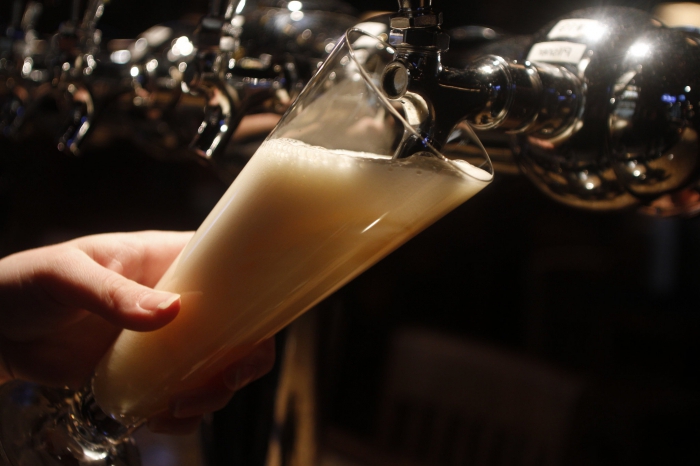 There are no fewer beer lovers in our country than in Germany. In this case, the culture of drinking a foamy drink until recently simply did not exist. That is why pasteurized and bottled surrogate was more popular.
There are no fewer beer lovers in our country than in Germany. In this case, the culture of drinking a foamy drink until recently simply did not exist. That is why pasteurized and bottled surrogate was more popular.
The market for such alcohol-containing liquids has continuously grown over the past 10 years, crowding out real beer. Since 2008, the rate of increase in sales began to decline markedly. Today, the trend boils down to the fact that buyers began to prefer a better product, and the producers of "live" beer have the opportunity to revive a wonderful tradition.
Quantitative indicators of the Russian brewing market
If you build a graph of the dependence of beer consumption on time, it will be seen that gradually our country has reached a European level in this indicator. Beer business in just 5 years, from 2001 to 2005, grew by more than 40%. Such numbers are very difficult to find in any other area. At the same time, the share of “live” beer was no more than 7% of the total product sold.
It would seem that there is simply nowhere to develop further, but already in 2006 the record was broken, and the mark of 1 billion decalitres was passed. In addition, some began to brew their own beer. True, it was rarely manufactured for sale.
You can assess the growth potential of any production by the indicator of final product consumption per capita. The beer business on it will soon reach a critical point in Russia. So, in our country, each person on average consumes 70-80 liters of foamy drink per year, while in the West these figures reach 100 liters. At the same time, as experts in the industry note, stagnation will least affect small domestic breweries specializing in the production of a “live”, non-pasteurized drink.
The need for quality change
In business, quality and quantity are very important indicators of success. They seem to complement each other. For example, a beer stall whose business plan does not take into account the possibility of expanding its range will inevitably go broke. Indeed, every day the competition increases, small shops are absorbed by large retail chains, in which prices for similar goods are much lower.
In fact, everything is not so bad. Even giant corporations can compete successfully. As evidence, we can cite statistical calculations, according to which almost 70% of beer produced in Russia belongs to a low-quality product. In Western countries, this figure does not exceed 25%. Such a large discrepancy in numbers suggests that the niche of "live" home-brewed beer is practically not occupied.
The history of brewing in our country
A breakthrough in the technology sector has led to a sharp increase in the number of manufactured goods available to the general public. There is nothing wrong with this fact, but at the same time there are a lot of quality connoisseurs who are ready to pay extra for it.

If we turn to history, it turns out that in the Russian Empire there were about 1000 breweries. For that time, this is a very decent indicator. In addition, they all brewed, in modern terms, "live" beer.
After the revolution, industrialization of all sectors of the national economy was paramount.In the first years of Soviet power, people were not up to beer, and then preference was given in favor of "popular" varieties of the drink.
After perestroika, a period began, which lasted until recently, when business began to dominate. Live beer was not of interest to merchants because of the laboriousness of the process of its production, as well as the low demand for the product. Indeed, a large number of people now look at beer as an alcoholic drink.
Accordingly, they make a choice in favor of the cheapest and strongest. At the same time, the systematic increase in excise duties by the state led to the fact that the price of cheap alcohol came close to drinks, which pasteurized surrogate clearly loses in quality. Therefore, we can predict a further increase in the popularity of "live" beer.
The main difference between "live" beer
Many people noticed that a modern foamy drink can stand on a store counter for months and not deteriorate. There is no trick in it, just manufacturers use preservatives and other chemicals. Otherwise, how to sell beer, which sometimes travels hundreds of kilometers, before reaching its consumer?

In the pre-industrial era, the intoxicated drink was brewed without any extraneous additives, but it spoiled on the second day.
“Live” beer can be compared to fresh milk, which few dare to sell on an industrial scale, as it turns sour very quickly.
It is very difficult to sell perishable products. For a novice entrepreneur, this problem is doubly relevant, since he has not yet developed a client base. It will take time to promote the product anyway.
The beer business is more than any other dependent on consumer demand. How to ensure delivery of a fresh foamy drink to a customer? In fact, a solution was found recently. It turns out the activity of brewer's yeast at temperatures below 2 aboutC drops markedly. They cease to consume the nutrients contained in the drink, and its shelf life increases significantly.
Thus, if you keep beer in special pins that will maintain the required temperature and ensure lack of access to oxygen, then the drink can remain fresh for 3 months.
How to start a business?
Live beer must be brewed under strict conditions. In this regard, you will need a room that meets all sanitary and epidemiological requirements. You will also have to spend money on special equipment needed for production and storage.
Before you open a store, it's best to try out the technology. Many well-known masters of their craft admit that at first brewing was a simple hobby for them. They cooked it to please themselves and their friends.
Practical recommendations for a novice brewer
The first steps in any business are the most difficult. It is very difficult for a beginner to immediately understand all the legal and economic intricacies. In order for the launch of the beer business not to fail, you need to be guided by some simple recommendations.
Before you plunge headlong into your favorite business, you need to draw up a business plan. It will help to achieve the greatest efficiency and quick return on investment. A business plan should consist of the following items: introductory and descriptive parts, market analysis, production plan, financial section.

The introductory part should be devoted to the assortment of products provided to the consumer. In the narrative, it is necessary to consider the process of selecting a room, production technology and possible ways of selling the finished product. Market analysis is the foundation of any business plan.
In this part, special attention should be paid to the presence or absence of competition and to determine the category of persons who are potential customers.The financial section should include a detailed description of the planned revenues and expenses.
After a business plan is drawn up, you can think about the legal form of business. It is best for a novice brewer to register as an individual entrepreneur. This will reduce the interest rate of taxes and facilitate the reporting process. Compared with a joint-stock company, such a legal form has only one drawback. It lies in the fact that the entrepreneur is responsible to creditors with all the property he has.
Since the alcohol market is under strict state control, in order to open a beer business you will have to collect a lot of documents. First of all, this is a license for trading activities, which is issued in the local administration.
I’ll have to try to get permission to produce beer. For this, it is necessary to successfully pass a check for compliance with GOST requirements. In addition, certificates of compliance of the premises with the SES and fire safety standards should be available. Also, you can not engage in retail trade without a registered cash register according to all the rules.
Product sales
 Brewing beer is not so difficult, there are many recipes in the public domain. Selling a finished product is much more difficult.
Brewing beer is not so difficult, there are many recipes in the public domain. Selling a finished product is much more difficult.
Small private breweries are sometimes difficult to find their customers. Consumers prefer well-known brands whose advertising spins all day on TV.
The business plan for live beer should also include marketing costs, but at the initial stage this is not so relevant.
The first customers and "walking advertising" will be relatives and friends. With a proposal to take a foamy drink for sale, you can contact the local bars.
One thing is for sure: it is almost impossible to break into a private brewer in a large trading network. This is due to their high requirements for quality and certification, as well as high entry fees. So, for example, exhibiting one wholesale unit of goods in a large retail network will cost no less than $ 1,000.
Payback
The beer business with the right approach to its organization is able to bring tremendous profit to its owner. Everything will depend on ambition and volume of production. The price of "live" beer is slightly higher than that of its pasteurized counterpart, therefore, to get the equivalent profit, it will need to be sold slightly less. A competent marketing move, as well as adherence to the technological process of production, will make it possible to recoup initial investments within the first 2 years.








